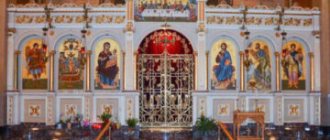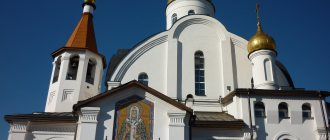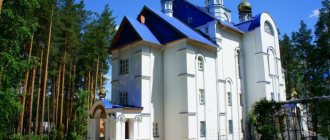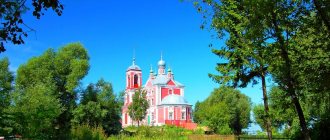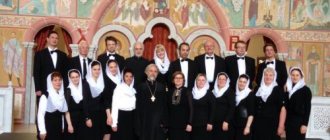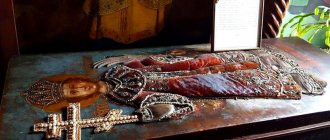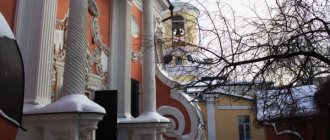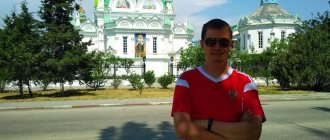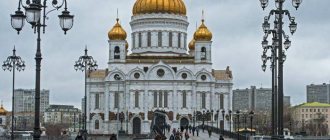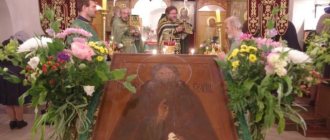Sukhumi and Abkhaz diocese
(formally within the Georgian Orthodox Church, in reality the status is not defined)
- Tel: +(995 44)-271971 (housekeeper of the monastery of St. Apostle Simon the Canaanite Hieronymus Andrey (Ampar)); fax: +(995 44)-260032 (diocesan administration)
- Cathedral city - Sukhum. Cathedral - Annunciation (Sukhum).
- Official site:
The Orthodox hierarchy in Abkhazia began in the first centuries of Christianity. It is known that the Bishop of Sevastopol, or Nikopsia, was present at the IV Ecumenical (Chalcedon) Council in 451. In 536, in ancient Nikopsia (Anacopia) or Pitsida, the episcopal see was revived, elevated in 541 to an archbishopric subordinate to the Patriarch of Constantinople. With the formation in the 8th century by Leon II of the Abkhazian kingdom, independent of the Eastern Roman Empire, which covered the entire territory of Western Georgia, the local Church gradually became independent. Around 840, the Nikopsian archbishops adopted the name of Bichvinta and Abkhazia, subsequently acquiring for themselves some rights of autocephaly. See the article Abkhaz Catholicosate for more details.
The Abkhaz-Imeretian Catholicosate, at different times being both dependent on Mtskheta and in an independent position, existed until the end of the 18th century, when the influence of the Russian Empire increased in the North Caucasus. The last Abkhaz Patriarch-Catholicos Maxim II remained in Russia in 1784 and died in 1795, after which the locum tenens of the Catholic see was Metropolitan Dosifei of Kutaisi, and in 1814 the Abkhaz Catholicosate was finally abolished. The church in Western Georgia came under the jurisdiction of the Georgian-Imereti Synodal Office and became part of the Georgian Exarchate of the Russian Orthodox Church.
On April 15, 1851, the Abkhaz diocese was restored as part of the Georgian Exarchate. Since 1869, the department was the Imereti Vicariate, and from June 12, 1885 it was renewed as an independent department under the name of Sukhumi.
After the collapse of the USSR and the subsequent Georgian-Abkhaz conflict, the Georgian bishop of the diocese, Metropolitan Daniel (Datuashvili), has been in Tbilisi since 1993. Since then, negotiations have been ongoing either on the entry of the diocese into the Russian Orthodox Church, or on the transition to the Ecumenical Patriarchate, or on the restoration of autocephaly of the Abkhaz Church. The Maikop bishop tonsured monks and ordained priests for the diocese. The Orthodox Church in Abkhazia is actually headed by priest Vissarion Aplia, chairman of the diocesan council.
Now limited to the borders of Abkhazia.
Bishops
- German (Gogolashvili) (September 8, 1851 - September 2, 1856)
- St. Alexander (Okropiridze) (September 2, 1856 - October 6, 1857, March 4, 1862 - May 30, 1869) for the first time - high school, archimandrite.
- Gerontiy (Papitashvili) (October 6, 1857 - November 16, 1859)
- St. Gabriel (Kikodze) (May 30, 1869 - 1886) v/u, bishop. Imereti
- Gennady (Pavlinsky) (December 28, 1886 - March 31, 1889)
- Alexander (Khovansky) (May 29, 1889 - February 12, 1891)
- Agafodor (Preobrazhensky) (March 2, 1891 - July 17, 1893)
- Peter (Drugov) (September 19, 1893 - January 17, 1895)
- Arseny (Izotov) (February 2, 1895 - March 26, 1905) [1]
- Sschmch. Seraphim (Chichagov) (April 10, 1905 - February 3, 1906) [2]
- Sschmch. Kirion (Sadzaglishvili) (February 3, 1906 - January 25, 1907)
- Dimitry (Sperovsky) (January 25, 1907 - July 25, 1911)
- Andrey (Prince Ukhtomsky) (July 25, 1911 - December 22, 1913)
- Sergius (Petrov) (December 22, 1913 - 1920)
As part of the Russian Orthodox Church
- Anthony (Romanovsky) (November 30, 1924 - 1927) senior, bishop. Yerevan
- Seraphim (Protopopov) (November 23, 1928 - April 3, 1930) high school bishop. Baku
As part of the Georgian Orthodox Church
- Spanish Ambrose (Helaya) (1918/1919 - 1921)
- John (Margishvili) (October 15, 1921 - April 7, 1925) [3]
- Christopher (Tsitskishvili) (April 7, 1925 - June 21, 1927) [4]
- Ephraim (Sidamonidze) (1927) v/u, ep. Tsilkansky
- Melchizedek (Pkhaladze) (1927 - 1928)
- Pavel (Japaridze) (1928)
- Varlaam (Makhaidze) (1929 - 1934)
- Melchizedek (Pkhaladze), 2nd time (1935 - 1943)
- Anthony (Gigineishvili) (1952 - November 24, 1956)
- Leonid (Zhvania) (1957 - 1964)
- Roman (Petriashvili) (1965 - 1967)
- Ilia (Gudushauri-Shiolashvili) (September 1, 1967 - December 23, 1977)
- Nikolai (Makharadze) (1978 - 1981)
- David (Chkadua) (1983 - October 1, 1992)
- Daniil (Datuashvili) (1992 - December 21, 2010) outside the diocese since 1993
- from December 21, 2010 - a diocese under the direct control of the Catholicos-Patriarch of All Georgia
Guide: Country of the Soul and its Orthodox shrines
A bit of local history
The Republic of Abkhazia (Apsny - “Country of the Soul”) is a state occupying 260 kilometers of the Black Sea coast, with a territory of 8665 square kilometers. Abkhazia is located on the Black Sea coast at the spurs of the Main Caucasus Range.
The small country borders on Georgia in the southeast, from which it declared independence in 1994 (the latter does not recognize the independence of the republic), and on Russia in the northwest, north and east.
The country does not have its own currency and uses the Russian ruble for payments. Abkhazia has its own mobile operators, Internet providers and banks, many of which are subsidiaries of Russian companies. For example, Sberbank of Abkhazia.
In practical and official life in Abkhazia, both Abkhazian and Russian languages are used. The population of the republic is approximately 240,000 people. Also, many people from Abkhazia who profess Islam today live in Turkey and other Muslim countries and have stable ties with their homeland.
The capital of Abkhazia is the city of Sukhum. In addition to Sukhum, 7 more settlements in the country have the status of cities, and the rest are villages. The main sectors of the economy of Abkhazia are: tourism, agriculture and winemaking.
About 51% of the citizens of Apsny profess Christianity, about 14% - Islam, 3% are pagans and 3% adherents of Abkhaz monotheism - the belief in One God - the Creator of all things (Antsva). In practice, many local Christians also gravitate towards Abkhaz monotheism, rarely visit churches and do not delve into theological subtleties.
Orthodoxy in Abkhazia today
Orthodoxy in Abkhazia is going through hard times. On the one hand, Abkhaz parishes legally belong to the canonical territory of the Georgian Orthodox Church. On the other hand, the majority of Georgian clergy were expelled from the territory of the republic during the Georgian-Abkhaz war. Many shrines of Abkhazia were robbed and damaged by Georgian troops, which caused indignation among local residents.
Therefore, in fact, the Abkhaz Orthodox Church (temporary administrator, Priest Vissarion Apliaa) seeks to move into the jurisdiction of the Moscow Patriarchate. Priests for Abkhazian parishes today study and are ordained in Russia, and during services here the name of the Patriarch of Moscow and All Rus' is remembered.
In addition, part of the clergy of the Abkhazian Orthodox Church, led by Archimandrite Dorotheos (Dbar), has gone into schism and is seeking to obtain autocephaly from the Patriarchate of Constantinople. They control the New Athos Monastery and several churches in other settlements.
Nature of Abkhazia
The nature of the country is its well-deserved pride. Most of the territory of Abkhazia has mountainous terrain. The highest mountain of the republic, Dombay-Ulgen, rises to 4048 meters above sea level. Many mountain slopes are decorated with waterfalls.
In addition to mountains, the topography of Abkhazia is characterized by karst formations. Not far from Gagra there is the deepest karst cave in the world - the Krubera-Voronya cavity, 2080 meters deep. Lake Ritsa, which arose in the mountains many centuries ago as a result of the collapse of one of them into the nearest river, is very popular among tourists.
Seascapes, wild rivers, mountain peaks and subtropical vegetation have made Abkhazia exceptionally picturesque. Pitsunda will add to this color the famous relict pines, cedars, cypresses and eucalyptus trees.
A little history of the region
Apsny has a rich history. From the 4th century BC, Greek colonies were created in these places, the first of which was Pitiunt (aka “Pitsunda” - from the Greek “pine”), and the second was Dioscuriada, the site of which is now Sukhum. Later, the Greeks were replaced by the Romans.
Around this time, the apostles Andrew the First-Called and Simon the Canaanite preached in the lands of the Abazgians. After his preaching, Christianity was gradually forgotten here, until the era of persecution began. In the 2nd-4th centuries, Abkhazia was often a place of exile for Christians. In the 4th century, Christianity in Abkhazia spread so much that Bishop Pitiunta took part in the First Ecumenical Council in 325.
Later, Abkhazia was under the rule of Byzantium, subject to Arab raids, and maintained Genoese trading outposts. In the 8th-10th centuries it was an independent kingdom and even controlled part of Western Georgia. In X-XV Abkhazia was part of the united Georgian principalities.
In the period from approximately the 13th to the 19th centuries, Abkhazia had its own Catholicos-Patriarch (whose canonical territory also included the principalities of Western Georgia), who over time moved the see to Imereti. Here the line of Catholicos was interrupted in the 19th century.
In the 15th-18th centuries, the lands of Abkhazia came under the rule of Turkey, which pursued a policy of forced Islamization of the local population. As a result of a series of uprisings, the Abkhaz were able to free themselves from Turkish rule and accept Russian citizenship at the beginning of the 19th century. At the same time, a significant part of the local residents who professed Islam (Mahajirs) were expelled to Turkey.
In the 20th century, Abkhazia was included by the central authorities of the USSR into the Georgian SSR, which the local population did not like very much. After the collapse of the Soviet Union, Apsny left Georgia. In 1994, the independence of the republic was proclaimed, and later an agreement on strategic partnership with Russia was concluded.
Orthodox shrines of Abkhazia
For ease of orientation for pilgrims, we will try to arrange the shrines in order of their geographical location when traveling from the northwest to the southeast of the republic:
Gagra . Here you can visit the cave of the locally revered Saint Hypatius of Gagra. The venerable hermit (not to be confused with the holy martyr Hypatius of Gangra) labored in a cave in the gorge of Mount Mamdzyshkha.
Pitsunda is famous for its huge cathedral, where in the Middle Ages the Catholicos-patriarchs of Abkhazia and Imereti worshiped. During Soviet times, the cathedral, due to its unique acoustics, was converted into a concert hall. A huge organ was installed here, which even today full houses of tourists gather to listen to.
Also on the territory of the cathedral there is a small functioning Orthodox church, preserved from the 10th century, the ruins of a larger Orthodox church, in which services are also held on an external altar in the summer, and a museum.
Lykhny . The ancient Assumption Church in the village of Lykhny (once the capital of the Abkhazian kingdom), built in the 10th-11th centuries. An active Orthodox church, where the tomb of Prince Safarbey Chachba-Shervashidze is located, under whom Abkhazia became part of the Russian Empire.
New Athos - in ancient times Anakopia, a city on the seashore in the very center of Apsny. Named after the local monastic monastery, founded here in the 19th century by Russian monks who arrived from the St. Panteleimon Monastery on Mount Athos.
The monastery is not only a beautiful architectural complex with beautiful temple paintings, but also has a number of technical attractions built under the patronage of the Russian emperors - its own hydroelectric power station and a railway along which firewood, timber and other cargo were transported to the monastery.
Currently, the monastery is run by schismatics led by Archimandrite Dorotheus (Dbar), who was banned from serving in the clergy, so it will be interesting to visit the monastery, but it is not worth staying for services in the monastery and the churches related to it.
On the Iveron Mountain of New Athos there is a chapel of the same name and a holy spring, which appeared here, according to Tradition, through the prayers of the monks to the Most Holy Theotokos.
In addition to the monastery, in New Athos there are several shrines associated with the Apostle Simon the Canaanite (Zealot), which are definitely worth worshiping. The apostle preached in Abkhazia and suffered martyrdom here.
In New Athos you can visit the cave of the Apostle Simon, a boulder with the imprint of the saint’s foot, a worship cross at the site of his death, as well as the temple where his relics were kept.
Komans . At the entrance to this village, located 15 kilometers from Sukhum on the western bank of the Gumista River, there is a source and the place of death of the holy martyr Basilisk (IV century).
On the way to Comany, the bus with pilgrims will definitely turn right. Literally 50-80 meters from the main road you will see a concrete staircase leading up a small hill. At the top of the hill stands the chapel of St. Basilisk. Here, under a layer of stones, the body of the martyr was buried.
Under the hill, a little to the side, a holy spring gushes out of a rock. According to legend, it was at the base of the spring that the saint met his martyrdom. Orthodox Christians take a dip in the spring, collect water and pray to Saint Basil before continuing on to Comana.
In Comana, another saint awaits believers - Archbishop of Constantinople John Chrysostom. It was here that he gave up his soul to God, without enduring the hardships of traveling into exile.
In the 11th century, a small temple dedicated to the saint was built at the site of the saint’s death. Later, it fell into disrepair and collapsed, as did the convent founded in these places at the end of the 19th century. But in 1991, the Chrysostom Church was rebuilt anew - using the materials and foundation of the ancient church and following its model.
In one of the boundaries of the Koman temple, the first stone sarcophagus in which the “great Cappadocian” was buried is exhibited for worship. Judging by the coffin, the great saint was quite short in stature - approximately 140-150 centimeters...
Finally, a few kilometers from the temple in the name of St. John Chrysostom is the site of the third discovery of the head of John the Baptist. You can get to it if you come to Comany as part of a jeep tour.
During the heyday of iconoclasm in Byzantium in the 8th century, the holy head of the Forerunner of the Savior was secretly taken out and hidden near Koman in order to save it from desecration. The head was found and returned to Constantinople about 100 years later, when the iconoclastic heresy was finally defeated.
Sukhum . Cathedral in honor of the Annunciation of the Blessed Virgin Mary in Sukhum. The current Orthodox cathedral, in which the temporary administrator of the Orthodox parishes of Abkhazia, Priest Vissarion Apliaa, performs services.
In Drandy, the monks of the monastery are restoring the buildings of the ancient episcopal residence. The local Assumption Cathedral was built back in the 8th century. Later, an entire complex was founded here with a hospital, a forge, a printing house, several hermitages and temples, workshops and a school, which was closed and looted with the advent of Soviet power.
Now, one of the premises on the territory of the former monastery has been fenced off and converted into the only prison in Abkhazia. The remaining buildings are gradually being restored by the monks. Thus, the Assumption Cathedral is already operational.
Mokva . Cathedral in honor of the Dormition of the Blessed Virgin Mary in Mokva, where many Abkhaz bishops, priests and representatives of the nobility were buried.
In the village of Ilor, a few kilometers from Ochamchira, there is a temple dedicated to the holy Great Martyr George the Victorious. Today here you can venerate the icon of the Holy Great Martyr Eustathius of Apsilia, but earlier in the temple there were miraculous images forged from silver, one of which belonged to the Great Martyr George the Victorious.
At the moment, the miraculous icons and other treasures of the Ilori temple have been lost, but once local residents not only prayed in front of it, but also made vows that they always tried to fulfill.
Bedia . The most beautiful monument of Abkhaz architecture is the temple in honor of the Blachernae Icon of the Mother of God in the village of Bedia, erected under King Bagrat III.
Travel tips
Getting to the cities of Abkhazia is easy in a huge number of ways: by regular sea catamaran, from Sochi or Tuapse; by train from several Russian cities (for example, Moscow-Sukhum, St. Petersburg-Sukhum); by train from Adler, by your own car through the Psou checkpoint. By bus from the Psou checkpoint (15 minutes by taxi from Adler airport, Sochi). Planes do not fly to Apsny. The nearest airport is Adler (Sochi).
In the republic, you can stay in comfortable hotels and boarding houses as part of a pre-purchased tour, but if you make the pilgrimage on your own, you can get a sufficient level of comfort in private hotels, of which local residents maintain a great many.
If, in addition to visiting shrines, you want to relax in nature, then it is better to settle in Pitsunda (a unique microclimate of relict pine forests and the sea) or further to the southeast - in New Athos or Sukhum, since Gagra is too close to Sochi and the sea here is not yet the same clean. For my part, as a base for further travel within the country, I recommend Pitsunda and even a specific guest house on Lesnaya 9A, from which I have personal positive impressions.
Depending on the choice you made with your accommodation, you can eat either from the hotel kitchen or in local cafes. I also recommend taking a closer look at the local market - in most guest houses you can also use the kitchen, so the market will allow you to save money.
It is possible to withdraw money here from a Russian bank card in Abkhazia, but only with a small commission, but non-cash payments are completely undeveloped. You can only use your SIM card while roaming. Therefore, it is better to take more cash with you on your trip and purchase a local SIM card.
I also advise you to be careful on the roads. Abkhazians, although they try to drive carefully, are not adherents of traffic rules. As they say themselves, “they lead by concepts.” The mountainous terrain further complicates vehicle travel. Often, because of the turn, you simply cannot see the oncoming car.
You can book excursions to shrines in any city in Abkhazia. Since there are several travel companies in the republic, it will not be difficult for you to choose a route that is interesting for yourself.
Attention! Local guides wonderfully describe the natural beauty of Apsny, but they know very little about the history of Christianity in the republic and its holy places. Temple workers will also be able to tell you little about local shrines. Therefore, before traveling to Abkhazia, it is better to purchase a good guide for pilgrims.
Andrey Szegeda
The photos accompanying the guide are taken from open sources and do not belong to the author of the text.
You can applaud the author (at least 10 times)110
Links[edit]
- Operating churches and monasteries of the Abkhaz Diocese
- The Sukhumi-Abkhazian diocese was renamed the Abkhazian Orthodox Church with the Sukhumi and Pitsunda patriarchates (in Russian). Administration of the President of the Republic of Abkhazia. 2009-09-16. Archived from the original on 2012-02-16. Retrieved September 26, 2009.
- Abkhazia: “We will kick out anyone.” Forum 18. April 7, 2009
- The conflict within the Orthodox community of Abkhazia has escalated again. Blagovest.info
May 15, 2006 Retrieved June 26, 2007 (in Russian) - The Georgian Patriarchate refuses to recognize the Abkhaz Orthodox Church. RIA News . September 16, 2009
- The Russian Orthodox Church "respects" the authority of the Georgian Church over Abkhazia, South Ossetia. Civil Georgia. September 16, 2009
- 38 temples and cathedrals were transferred to the Abkhaz Orthodox Church for free, indefinite use. . Apsnypress
. February 9, 2011 Archived from the original on 2011-07-21. Retrieved February 25, 2011. - ^ a b
The Abkhazian Orthodox Church declared its independence (in Russian). Caucasian Knot. 2009-09-16. Retrieved September 26, 2009. - Kuchuberia, Angela (November 17, 2009). “Archival copy” The Abkhazian Orthodox Church addressed the clergy of Georgia with a fraternal message (in Russian). Caucasian Knot. Archived from the original on August 11, 2011. Retrieved November 29, 2009.CS1 maint: archived copy as title (link)
Operating temples
- Sukhumi Cathedral of the Annunciation of the Blessed Virgin Mary. The rector of the cathedral is Priest Vissarion Apliaa (pictured). The clergy of the cathedral: Hieromonk Andrey (Ampar), Hieromonk Sylvestor, Deacon Gregory. Address: Sukhum, st. Abazinskaya, 75. Tel. 6-33-33, (8 442) 73333.
- Church of the Intercession of the Blessed Virgin Mary in Gagra. The rector is Hieromonk Pavel (Kharchenko). Address: Gagra, st. Apsny, 22.
- Temple-chapel of the Pitsunda Saints in the village of Pitsunda. The rector is Hieromonk Dorofei (Dbar). Address: Gagrinsky district, Pitsunda village. Tel. (8 442) 72504.
- Church of the Intercession of the Virgin Mary in Gudauta. The rector is Hieromonk Basilisk (Leiba). Priests of the temple: Hierodeacon Savvaty (Lagutin). Address: Gudauta, st. Kharazia 26. Tel. (8 442) 50192.
- Church of the Assumption of the Virgin Mary in the village. Lykhny. The rector is Archpriest Peter (Samsonov). The serving priest is Hieromonk Ignatius (Kiut). Address: Gudauta district, village. Lykhny. Tel. (8 442) 32511.
- Church of the Intercession of the Virgin Mary in New Athos. The rector is Hieromonk Dorotheos (Dbar). Address: Gudauta district, New Athos. Tel. (8 442) 72504.
- Temple of the Holy Apostle Simon the Canaanite in New Athos. The serving priest is Hieromonk Dorotheos (Dbar). Address: Gudauta district, New Athos. Tel. (8 442) 72504.
- Church of the Transfiguration of the Lord in the village. Yashtukha. The rector is Hieromonk Gregory (Khorkin). Address: Sukhumi district, village. Yashtuh.
- Church of Saints Equal-to-the-Apostles Constantine and Helen in the village. Akapa. The rector is Hieromonk John (Svinukhov). Address: Sukhumi district, village. Akapa. Tel. 6-31-64.
- Temple of the Prophet Elijah in the village of Agudzera. Address: Gulripsha district, Agudzera village. Tel. (8 442) 74470.
- Drandsky Assumption Cathedral. The rector is Hieromonk Dorofey (Dbar). Address: Gulripsha district, Dranda village. Tel. (8 442) 72504.
- Temple of the Archangel Gabriel in the village of Dranda. Address: Gulripsha district, Dranda village.
- Mokva Assumption Cathedral. The clergyman is Priest Igor Artemyev. Address: Ochamchira district, village. Mokva. Tel. (8 442) 72348.
- Church of St. George the Victorious in the village. Yelyr. The rector is Hieromonk Sergius (Jopua). Address: Ochamchira district, village. Yelyr.
- Church of St. George the Victorious in the village. Chuburkhinji. The serving priest is Priest Nikita Adleyba. Address: Gali district, village. Chuburkhinji.
Active monasteries
- Monastery of the Holy Apostle Simon the Canaanite in New Athos. The rector is Hieromonk Andrey (Ampar). The number of inhabitants is 25 people. There are two churches on the territory of the monastery: the Cathedral of the Holy Great Martyr Panteleimon and the Church of the Martyr Hieron. Address: Gudauta district, New Athos, monastery. Tel. 2-40-23, 2-40-26, (8 442) 71971. The monastery is open to the public every day from 12.00 to 19.00, except Mondays and Lent.
- Monastery of St. John Chrysostom in the village. Teams. The rector is Hieromonk Dorofei (Dbar). Number of inhabitants - 5 people. There are two churches on the territory of the monastery: the Church of St. John Chrysostom and the Church of the Martyr Basilisk. Address: Sukhumi district, village. Komani, monastery. Tel. (8 442) 72504.
| Monastery of St. John Chrysostom | Tomb (sarcophagus) of St. John Chrysostom |
| Monastery of St. John Chrysostom, top view | Source of the Holy Martyr Basilisk |
* This sarcophagus, in which the relics of St. John Chrysostom rested for 30 years, was transported from the Komansky temple to the Sukhumi Cathedral in 1967. In 1990, after restoration work was carried out at the Komansky monastery, the tomb of Chrysostom was returned to its original location.
Based on materials from the Official Website of the Abkhaz Orthodox Church https://www.aiasha.ru/
